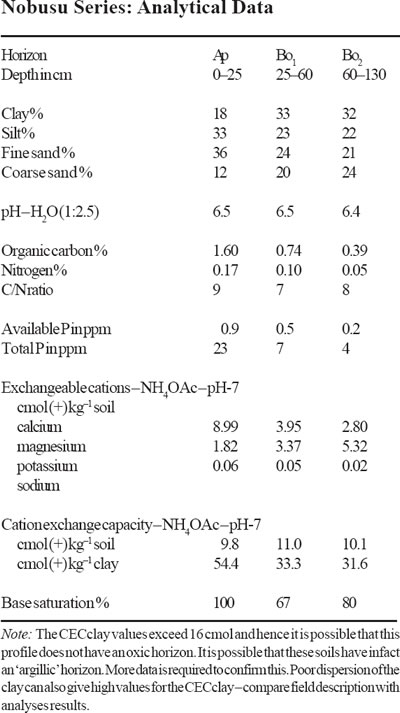Soil Profiles: Nobusu
Nobusu Series
The Nobusu Series is a member of the Nobusu Family which is a fine, oxidic, isohyperthermic brown Tipik Tempalemoks. It typifies this family and is developed over alluvium and outwash from basic and ultrabasic rocks. Soils of the Nobusu Series are characterized by their deep, moderately well to well drained oxic horizon with a clay content of 35–60%, a colour which is brown to yellowish brown and an ECEC of more than 1.5 cmol (+) kg–1 clay. Structures are weak medium subangular blocky and consistence is friable
Type Location
Soils of the Nobusu Series were first established during the reconnaissance soil survey of Sabah (Acres et al. 1975) as the Nobusu Family. The above pedon was described by Paramananthan (1996) in Meliau Estate, near Telupid, Sabah. The above pedon was located on gently undulating terrain (4–12% or 2–6° slopes) at an elevation of around 16 m (50 feet) a.s.l. under oil palm. Location: Topographic Sheet 5/117/1, 5°47’20” N, 117°11’45” E (Grid Reference 5/117/ 1 – 987396 m).
Range in Characteristics
Little is known about the range in characteristics of the Nobusu Series. As mentioned earlier the Nobusu Family as mapped earlier had reddish brown to brown colours and also a clay content that ranges from 35 to 75%. The Nobusu Series as redefined here must have an oxic horizon with a hue of 7.5YR or yellower and a value/chroma of 5/3, 5/4, 4/3, 4/4, 3/3, 3/4 at 50 cm depth. The clay contents in the oxic horizon should be between 35% to 60%. Drainage is moderately well to well drained. Structures are weak medium to fine subangular blocky and consistence is friable. The ECEC values must be more than 1.5 cmol (+) kg–1 clay.
Competing Soils and Their Differences
As very few Oxisols are developed over alluvium these soils are not likely to be confused with many other soils. The presence of a brown coloured oxic B horizon can confuse the Nobusu Series with the Kuantan Series and Table Series over basalt. The Kuantan Series occurs on undulating to rolling terrain and has a ECEC of less than 1.5 cmol (+) kg–1 clay. The Table Series has brown colours and the same ECEC (> 1.5 cmol) as the Nobusu Series, but is a heavy clay (> 60% clay) textured soil. The Ambun Series over serpentinite has similar textures but is reddish brown in colour. Some soils such as the Besar Series can have similar colours but have an argillic horizon.
Setting
The soils of the Nobusu Series typically occur on level to undulating terrain (alluvial terraces, colluvial deposits) adjacent to steephills of basic or ultrabasic rocks. Terrain is level to undulating (0–12% or 0–6° slopes) at elevations of up to 200 m (600 feet).
Principal Associated Soils
Soils of the Nobusu Series being developed over alluvium from basic and ultrabasic rocks are associated with soils of the Pinianakan Series, Ambun Series and Table Series. These soils typically occur on rolling to steep terrain, have heavier textures or reddish brown colours.
Drainage and Permeability
Soils of the Nobusu Series are moderately well to well drained. Permeability is moderate to good.
Use and Vegetation
In the Telupid area where such soils have been mapped the Nobusu Series is mainly under primary forest. Some small areas have recently been planted with oil palm.
Distribution and Extent
The Nobusu Series has to-date been only mapped in Sabah mainly in the Telupid area. Their actual extent is not known.
Series Established
This soil was established during the reconnaissance soil survey of Sabah (Acres et al. 1975). The source of name is not known.
Remarks on Classification
The Nobusu Series is classified here according to the Malaysian Soil Taxonomy – Second Approximation (Paramananthan 1998) as a member of the fine, oxidic, isohyperthermic, brown family of Tipik Tempalemoks over alluvium from basic and ultrabasic igneous rocks. They are classified here as soils having a deep oxic horizon with a clay content of 35–60%, yellowish brown to brown colours and a ECEC of more than 1.5 cmol (+) kg–1 clay. In the Keys to Soil Taxonomy – Eighth Edition (Soil Survey Staff 1998) these soils would probably be classified as Typic Hapludox. In the FAO/ UNESCO Soil Map of the World – Revised Legend (FAO 1990) the Nobusu Series would probably be classified as Haplic Ferralsols.
Suitability for Agriculture
The main limitation for agriculture for these soils is their generally low fertility status. With proper fertilization these soils are capable of supporting a wide range of crops.



